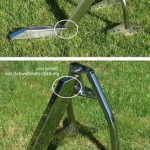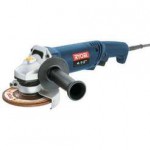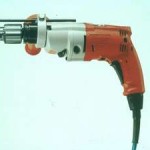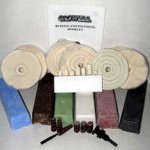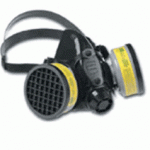Polishing Stainless
I am constantly asked, how do you get the stainless so shiny?, well, the answer is quite simple….its takes a lot of work, for instance, box section used to make the swan neck is grained with fine lines, these have to be removed first before the polishing can be started, I use Bibielle discs and pads, Course at first and then finer and finer grades until the stainless looks scratch free.
I then move onto sisal, and then finishing and buffing mops with the correct soaps and compounds, and finally rubbing the stainless with a soft cloth dipped in lime powder…..it does take a long while to do and is a very messy job.
I can spend over two hours just doing one side rail plate for instance.
It infact takes me longer to polish a buggy than it takes to make one.
Note:- There are other products out there that will do the job just as well, but these are the products I use.
- 4.5 Angle Grinder
- Electric Drill, or a Bench Grinder
- Polishing Kit
- Use a dust mask in a well ventilated area
There is only one way to go.
Use an abrasive as tough as what you’re up against. That means Stainless Steel abrasive compounds. These are compounds specifically designed to do the job.
One of the greatest risks when working with materials this tough is over heating. Over heating will not only warp your item, but if it is tempered you will break down the tempering and soften the surface. If your work piece is stainless steel you may cause it to release many of its oxides and carbon. Then it won’t be stainless any more and will rust like ordinary steel
If you have a finished product that you are trying to maintain a mirror finish on, at least 95% of hand polishes are a waste of time. Most of them will do no more than clean the surface at best, and at worst they will make it hazy by leaving light scratches in the finish. This is because they cut a little and loose their shine quickly.
The polish must have a serious abrasive to do anything. With most stainless, hand polishing is pretty much a waste of time. English Custom Polishing is one of the few manufactures of liquid polishes that will cut these metals, but be prepared for slow going.
If you are trying to do any more than clean up a mirror finish which is in good shape, forget it unless you have power tools. With a fabrication you cannot use abrasive compounds and buff wheels to remove machine or grain marks from manufacture as you can in aluminum or other softer metals. You have to cut with the correct tools. I like the nonwoven wheels, belts and discs. They manufacture the finest bladder wheels and beltfiles in the world. When you have a large area, it’s time to use belts for straight line stability.
Nonwoven belts and wheels will give you a reasonable finish, but still leave you a long way from that perfect mirror. It is important that at every stage you remove all signs of the previous cut, which will not always be easily visible. So we try to make each cut cross it’s previous one at 90 degrees, this way we can see the scratches.
From here on in it will not be quite as easy to see the scratches as the finish comes up to your mirror.
Now it is time to buff wheel.
The first cut should be done with a good heavy stainless compound, and a good stiff buff wheel. I use a Sisal Mop, it is stiff enough to put it down on the piece, and has a degree of flexibility for irregular shapes. The cut should be done in consistent straight lines of course and when finished will leave quite a nice, even mirror.
The fine stainless cut should be done with a pleated mill buffing mop. These are still quite stiff and do an excellent job. The finest cut should be done with an untreated canvas mop.
Each cut should, where ever possible, cross the previous one at 90 degrees. This will show up any marks left in from the previous cuts. Only when all marks are gone are we ready to proceed to the next cut.
The finishing touches are about to be done.
This cut should be done with a very loose linen or cotton mop.
Polishing Tips
When we are polishing any metals there are always things to be taken into consideration.
Things that make life easier, healthier, safer, quicker or basically deliver better results.
Here are some of the tricks that will save you time and effort.
1) Clean up your work as much as you possibly can before you try to polish it.
2) Clean up your work area regularly placing hazardous tools and chemicals out of harms way.
3) Avoid build up of buffing dusts, soiled cloths, or mixing dusts and cloths.
4) By mixing solvents , various metal buffings, shavings, and maybe a bit of oil in a bin we have the potential for a big firework. Don’t do it.
5) Do not smoke, use open flame burners or any other source of ignition in a fume or dust laden atmosphere. People often forget about dust explosions. They are normally fatal.
6) Clean up your work piece between every buffing stage with either alcohol or mineral spirits to remove dirt and residue from compounds.
7) Any abrasive or polish is only as fine as its coarsest component.
8) Use cloths that have no labels and preferably no sewn edges.
9) When you are polishing large pieces, do small areas at a time, it’s faster and more consistent.
10) When you do a final polish, clean up and then buff it out. Any dirt on the cloth? Buff it again
11) Never put waxes over chrome. It makes it look hazy.
12) Remove buff lines with lime powder.
13) Remove surplus waxes and polishes from seams, pit marks or awkward to get at places with lime.
14) Mist your final buffing with a light misting of water and buff it again. This seals both metals and waxes and helps reduce water stains from rain and condensation
15) Always use top quality soft cloths for your final buffing.
16) Use light pressure, especially on polishing strokes when power buffing. It reduces scratches.
17) Always move buff machines slowly across work pieces, again, less scratches.
18) Never, ever, use anhydrous solvents, ammonia or acids, or polishes that contain them on aluminum, Brass, Copper or bronze. They eat Zinc and attack most alloys. Brass is Zinc and copper, it is normally present in aluminum, it is used to make many steels and alloys less corrosive.
19) Always try to make finishing strokes with machines or by hand in the direction of the grain if the metal is rolled.
20) If you use electrical tools make sure there is a MCB breaker in the line. It might save your life.
21) If you use air tools drain your tanks regularly, and if you can put an air drier between the compressor and the tank. Dry air equals less rust. Your tank will last a life time.
22) Don’t rush your polish job. It will show.
23) Always wear safety glasses when working with power tools.
24) Always use liquid polishes, pastes, paint strippers, solvents, etc. in well ventilated areas.
25) Never, ever, remove oil, grease, buffing compound from the skin with solvents, mineral spirits, or similar chemicals. If soap and maybe a little pumice wont do it. stay dirty, it’ll wear off. Use chemicals and you may save the undertaker a little formaldehyde, but other than that, the potential results are all negative.
26) Avoid particulate absorption of metals. Excess metals in the system cause all sorts of disorders and they are readily taken in through the skin and lungs.
27) The easiest way to reduce contamination is to polish in the open air and in areas where the is a cross flow of air
28) Don’t let all my warnings get you down or frighten you, just be sensible and enjoy your polishing safely.
29) Remember that polishers always have a bright future.

